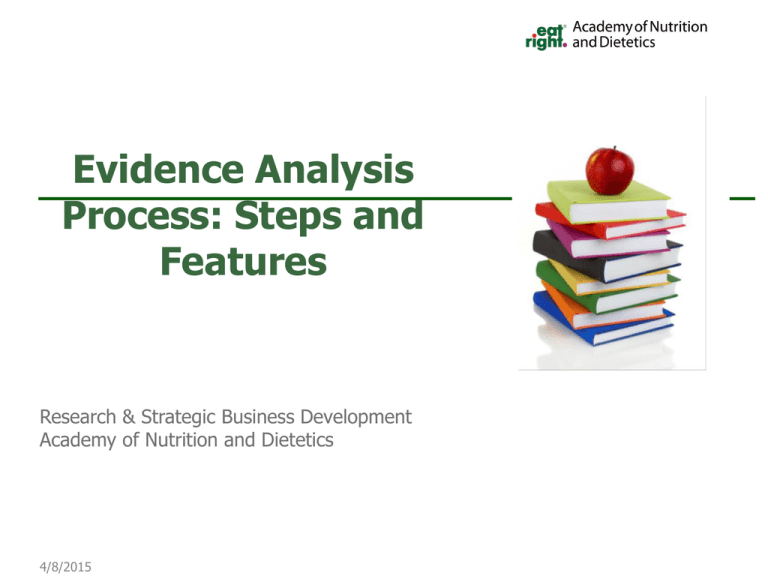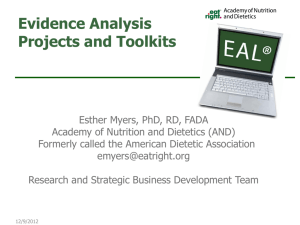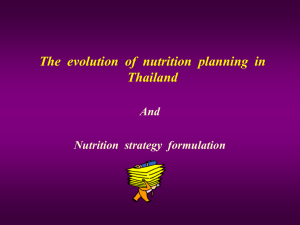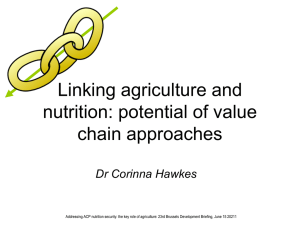Academy`s Evidence Analysis Process
advertisement

Evidence Analysis Process: Steps and Features Research & Strategic Business Development Academy of Nutrition and Dietetics 4/8/2015 Presentation Objectives Understand the Steps in the Academy of Nutrition and Dietetics’ Evidence Analysis Process Identify topics and features in the Academy’s Evidence Analysis Library Evidence Analysis Library FREE to Academy Members! www.andevidencelibrary.com Online resource with the best available research on important dietetics topics in a practitioner-friendly format 3 Definition “Evidence-Based Dietetics Practice” is the use of systematically reviewed scientific evidence in making food and nutrition practice decisions by integrating best available evidence with professional expertise and client values to improve outcomes.” Definition developed by A.N.D. Evidence-based Practice Committee with input from Research Committee, Quality Management Committee, and Scope of Dietetics Practice Task Force. Approved by A.N.D. House of Delegates Leadership Team 4 Why Evidence-Based? Improve quality of healthcare Decrease wide variations in practice Reduce the gap between what is known from research…and what happens in real life Take advantage of biomedical knowledge Evidence-Based Practice Committee Oversight • Evidence Analysis Process • Evidence Analysis Library® • Evidence Based Products (e.g., Guidelines, Toolkits, Educator Modules) Promotion • Promote the implementation of evidencebased dietetic practice • Develop strategies for dissemination Functions • Appoint Expert Workgroup members • Prioritize Evidence Analysis projects • Determine format and content of products • Evaluate Evidence Analysis process Structure of EBP Committee Joint Academy House of Delegates & Board of Directors appointed committee Nutrition Care Process/SL Committee Coding and Coverage Committee Board Of Directors Ambulatory Care ADA EBP Committee Quality Management Committee Acute Care Practice Research Committee Trained as evidence analysts Long-Term Care Practice Evidence-Based Practice Committee 2011-2012 Ainsley Malone, MS, RD, LD, CNSD, Chair Patti Landers, PhD, RD, LD, Vice Chair Members: Kathy Camp, MS, RD, CNP Linda Farr, RD, LD Heather Holden, RD, LD, CDE Toni Kuehneman, MS, RD, LMNT Jessie Pavlinac, MS, RD, CSR, LD Susan Smith, MBA, RD Pat Splett, PhD, MPH, RD, FADA Bill Swan, RD, LD Academy’s Evidence Analysis Process A rigorous and systematic process for searching, analyzing and summarizing research on a specific nutrition topic. Evidence Analysis Workgroup Experts Appointed Key Functions • Experts in the field or Project Topic • Appointed by the Evidence-Based Practice Committee • • • • • Formulate Questions Set Inclusion/Exclusion Criteria Review materials Grade conclusion statements Provide Final approval Project Managers/Lead Analysts Manage Project • Facilitate work of team • Schedule & assign work • Manage online information Lead Teleconferences and Meetings • Assist workgroup chair in leading teleconferences • Prepare agendas • Help Group to reach consensus Mentor Analysts and Review their Work • Worksheets • Quality Criteria Checklists • Overview Tables • Evidence Summaries • Draft Conclusion statements Steps in the Evidence Analysis Process Step 1: Formulate Question Step 2: Gather Research Step 3: Appraise Articles Step 4: Summarize Step 5: Grade • Develop the Question • Gather and Classify the Research • Critically Appraise Each Article • Summarize the evidence in an Overview Table and Evidence Summary • Develop Conclusion Statement and Grade the Strength of the Supporting Evidence Step 1: Formulate the Question 13 Formulate the Question We ask questions to… Identify relevant research Identify areas where knowledge for practice is needed Connect scientific research knowledge to practice Focus the Approach to the Research 14 Nutrition Care Process Nutrition Assessment Nutrition Diagnosis What do you do at each step in the nutrition care process? Evidence analysis should focus on answering questions related to these steps. Nutrition Intervention Nutrition Monitoring And Evaluation Outcomes Example Question 16 Step 2: Gather and Classify the Research 17 Search Plan & Results for Each Question Reports Inclusion & Exclusion Criteria Date of Search Inclusion Criteria: -Age -Setting (outpatient) -Sample Size -Acceptable dropout rate -Year Range -English Language Databases Searched Search Terms List of Articles 18 Search Plan & Results Included articles and Excluded articles (with reason) List reason for exclusion for each article not included in the analysis; e.g. Sample size too small 19 Step 3: Critically Appraise Each Article 20 Worksheet Citation / PubMed ID Date Study Design Class Rating (+/0/-) Research Purpose Inclusion Criteria Exclusion Criteria Description of Study Protocol Data Collection Summary Description of Actual Data Sample Summary of Results Author Conclusion Reviewer Comments 21 Quality Criteria Checklist Questions related to relevance and validity Determines if article is rated as: Positive Quality Negative Quality Neutral Quality 22 Step 4: Summarize the Evidence in an Overview table and Evidence Summary 23 Narrative Evidence Summary Example: Summary of evidence for Low Glycemic Diets question 24 Overview Table List : Citation Study Design Quality Rating Sample Size Interventions & Outcomes Table format to enable user to compare studies side by side. 25 Evidence Summary - Bibliography Citations linked to worksheets at the bottom of the Evidence Summary 26 Step 5: Develop Conclusion Statement and Grade the Strength of the Supporting Evidence 27 Conclusion Statement Consumption of ad libitum lowcarbohydrate diets and reduced calorie diets both result in lower caloric intake. However, ad libitum low carbohydrate diets resulted in greater body weight loss and fat loss in the first six months. After one year, these differences are no longer significant. Grade II 28 Explanation of Grades % of Grade I questions on EAL 29 Published on the EAL® Available free to All Academy Members Question Conclusion Grade Evidence Summary Overview Table Worksheets and Quality Checklists for each article Search Plan & Results Individual EAL Subscriptions are available from www.adaevidencelibrary.com Store For Institutional EAL subscriptions, contact khowarter@eatright.org 30 How Much Content is on the EAL ? ® Abstracted Articles/Worksheets 115 EAL® Page Views by Calendar Year Calendar Year 2004 2005 2006 2007 2008 2009 2010 2011 Total Avg per Month 41,332 4,592 378,026 31,502 1,068,758 89,063 1,544,119 128,677 1,795,645 171,014 2,321,594 193.466 2,457,410 204,784 3,009,230 250,645 Overall Total Sept 2004 – Dec 2011 Over 12,500,000 page views EAL ® Usage Worldwide Users from 206 different countries 33 Evidence Analysis Library Projects Diseases & Conditions • Adult Weight Management • Aging • Athletic Performance • Bariatric Surgery • Breastfeeding • Celiac Disease • Chronic Kidney Disease • COPD • Critical Illness • Diabetes 1 & 2 • Disorders of Lipid Metabolism • Gestational Diabetes • Heart Failure • HIV/AIDS • Hydration • Hypertension • Oncology • Pediatric Overweight & Pediatric Wt Management • Pre-Diabetes • Spinal Cord Injury • Unintended Weight Loss for Older Adults • Wound Care Nutrients • Dietary Fatty Acids • Fiber • Fluoride • Nutrient Supplementation • Sodium • Topics from other projects cross-linked • e.g., Athletic Performance & Macronutrient Intake, Vitamin C and Oncology, Omega-3 and Disorders of Lipid Metabolism Foods • Advanced Food Productions and Sustainable Agriculture • Nutritive and NonNutritive Sweeteners ----Aspartame ----NNS • Vegetarian Nutrition • Topics from other projects cross-linked • e.g., Nuts and Disorders of Lipid Metabolism, Oats and Gluten Intolerance, Dairy and Childhood Overweight Nutrition Care Process • Assessing Energy Expenditure: Measurement vs. Estimation • Health Disparities • Medical Nutrition Therapy Effectiveness • Nutrition Counseling • Nutrition Screening • Topics from other projects cross-linked • e.g., Diabetes and MNT Effectiveness, Critical Illness and costeffectiveness Guideline Development After Analysis is Completed Develop algorithms based on Nutrition Care Process Draft guideline recommendations In-person, 2-day meeting to finalize entire guideline Internal/external review and revise Publish guideline on EAL® Evidence-Based Nutrition Practice Guidelines Evidence-Based Guidelines… A series of guiding statements and treatment algorithms Developed using a systematic process Assist the practitioner in decision making for appropriate nutrition care Evidence-Based Practice Resources What are Evidence-Based Toolkits? Toolkits are disease specific and include Protocol forms Case Studies Patient progress forms Outcomes management forms Client education resources Incorporate the Nutrition Care Process Electronic downloadable purchase item Toolkit Development Develop toolkits to apply guidelines Conduct 60-day usability test of toolkit and revise EBPC Review and Approval Make toolkits available for purchase Resources Click on Store on EAL for toolkits, Educator Modules and additional resources. Click on Resources on EAL for evidence-based Position Papers. 39 Steps in the EA Process Annual review of Evidence Analysis Guideline Projects Review Re-run searches for each question Determine if revision is needed Document date of review Revise “Revise” using EA Process Update rating of conclusion statements/recommendations as needed 40 EAL® Tutorial Module 1: Introduction and Features of the EAL Module 2: ADA Evidence Analysis Process • Signing-in • Help and FAQs • Locating Evidence Analysis Projects • A-Z Index • Search Feature • Print and Bookmark Queue • Printing • Search Plans & Results • Conclusion Statements • Evidence Summaries • Worksheets • What is the ADA Evidence Analysis Process and why do we use it? • Topic Selection • Appointment of Workgroups and Evidence Analysis Training • Formulating the Questions • Gathering and Classifying Evidence • Critically Appraising Each Study • Writing the Evidence Summary • Grading the Conclusion Statement Module 3: Evidence-based Nutrition Practice Guidelines and Toolkits • • • • • • • • Guideline Introduction Executive Summaries Major Recommendations Recommendation Rating Scale Algorithms Print Reports Feature Evidence-based Toolkits Store Summary Academy’s Evidence Analysis Library can be found at: www.andaevidencelibrary.com Questions contact: eal@adaevidencelibrary.com 42








